Affiliate disclosure: This post may contain affiliate links. Please see our Privacy Policy.
Dandelions are one of the best-known wild edible flowers of spring, but are you really sure you know how to identify them? They’re incredibly common, but so are their look likes, and every spring, I see dozens of posts on social media where someone’s harvested a whole basket of “dandelions” that are really just a look alike.
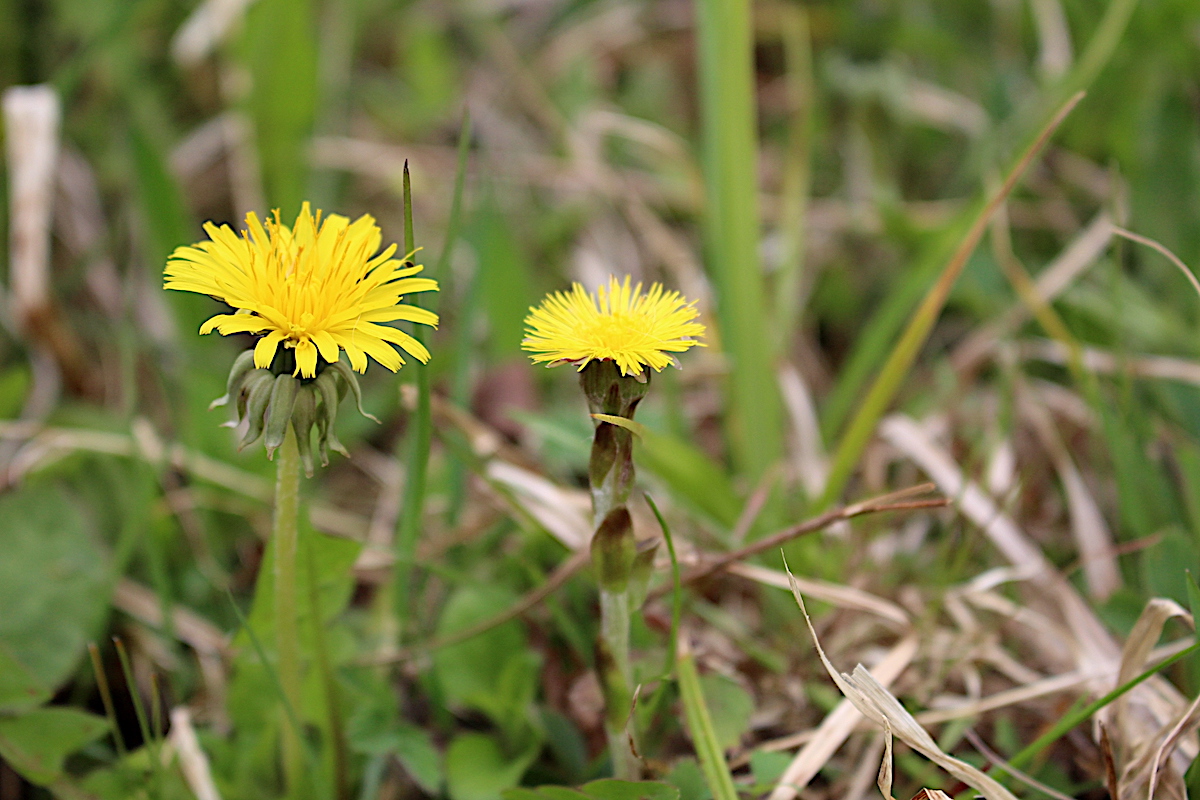
Dandelions are one of the most popular wild edible plants, largely because they’re incredibly common and widespread. Every part of the dandelion plant is edible, from its sunny blossoms to the tip of its roots. That makes it easy enough to turn garden “weeding” into “harvesting.”
A simple dandelion greens pesto is absolutely delicious, and many of us have grandparents who talk about making old-fashioned dandelion wine. And in 2020, with everyone stuck at home, it seemed like everyone was trying their hand at making dandelion jelly with backyard flowers.
The problem is people tend to assume that every low-growing yellow flower is a dandelion, and that can be problematic.
Dandelion has at least a dozen look-alikes in the US, and while it’s easy to identify if you’re actually paying attention. Still, many people simply don’t look all that closely.
A herbalist friend of mine just confided that after a decade of harvesting “dandelions” each spring, she learned that that the early blooming yellow flowers she’s been picking are actually coltsfoot (which usually blooms a few weeks before dandelions). She’d always heard that “dandelions are the first flowers of spring for the bees,” which isn’t at all true, but she assumed that those even earlier yellow flowers must be dandelions!
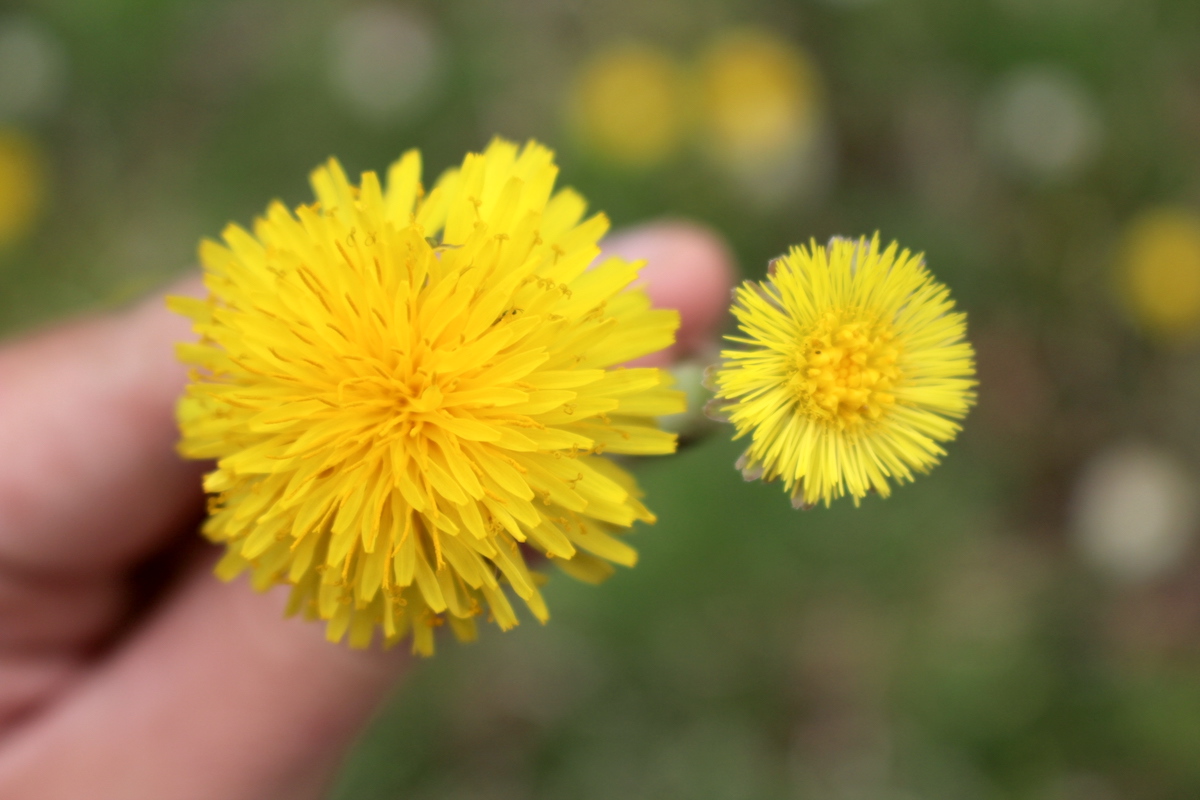
Food bloggers and YouTubers make the same mistakes, too. If you look closely, this video about dying wool with dandelions doesn’t use dandelions but another early yellow flower. (Conveniently, in this case, the results are the same, so no harm.)
This recipe for dandelion lemonade doesn’t use dandelions, and while she’s put in some stock photos of real dandelions, the actual photos with the lemonade (like this one) are not at all dandelions. She has a bitter look alike, and while not toxic, it’s not tasty either!
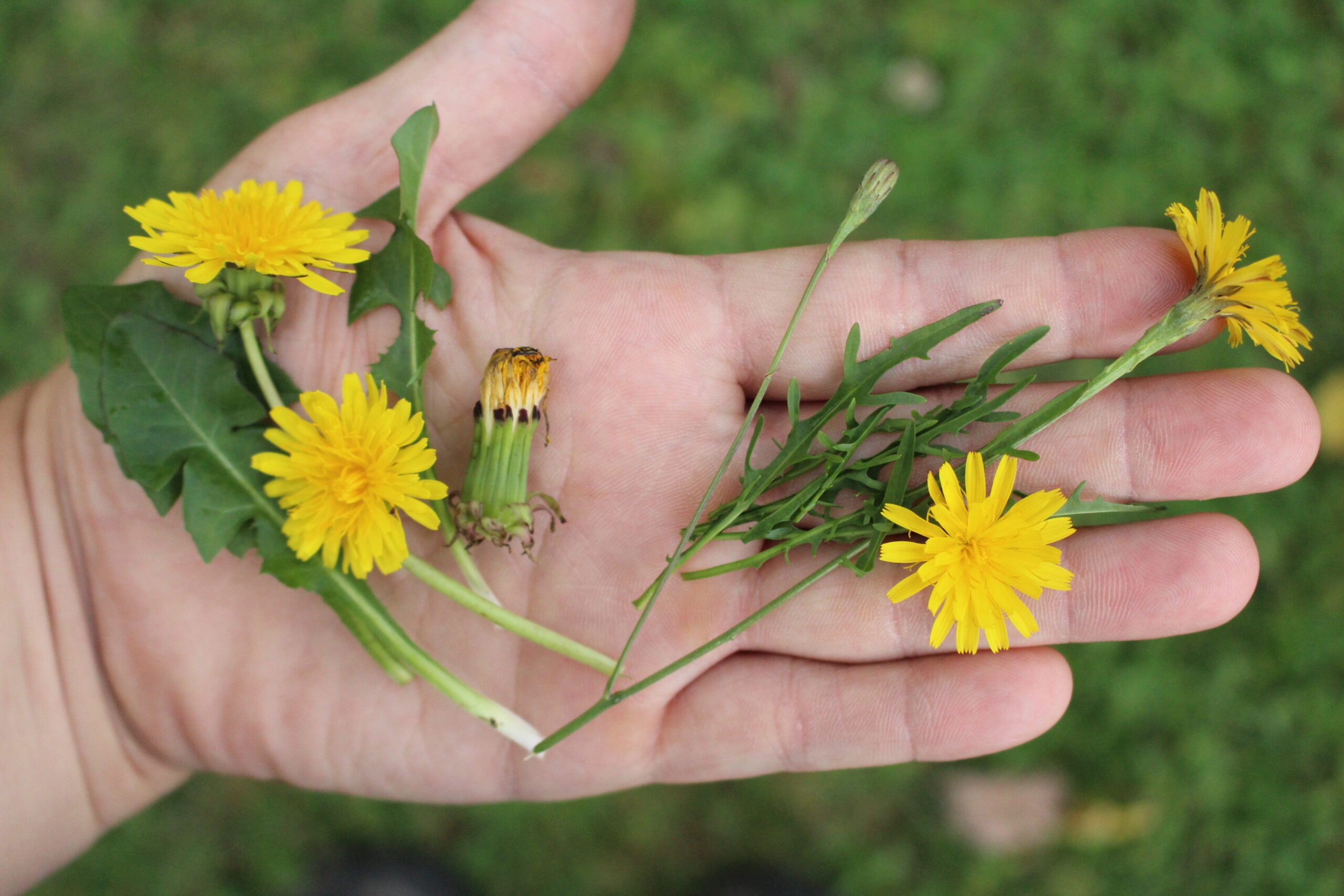
Even my own little ones make that same mistake often enough.
I forage all year long with my kids, and they could easily identify dozens of different wild edible plant species before they were five years old…but mama always checks. Even these littles make mistakes, especially when they’re excited.
My daughter couldn’t wait to make dandelion cookies when she came across a surprise patch of “dandelions” in September and eagerly started picking…only to have this mama ask her to pause and look a little closer.
She had the branching stems of Autumn Hawkbit, also known as “Fall Dandelion,” because the flowers look very similar to a casual glance.
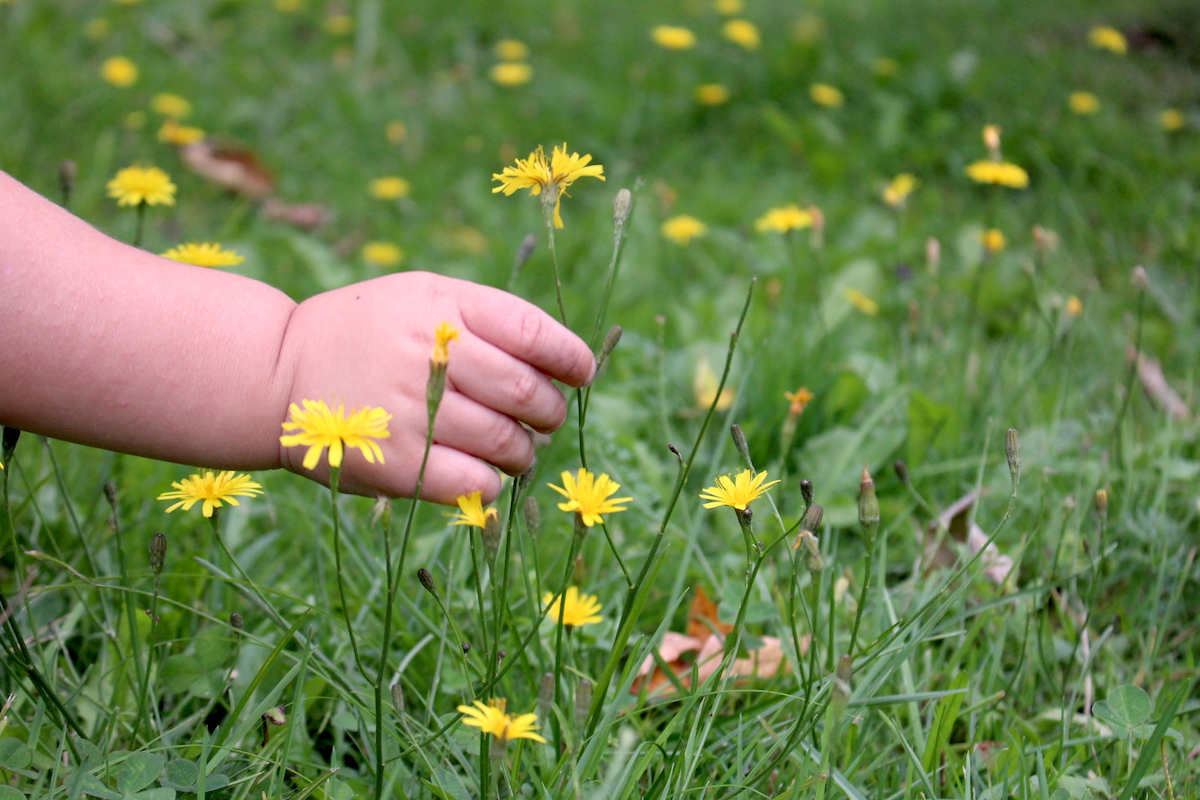
The good news is that dandelion doesn’t have any toxic look-alikes. At least, not in small quantities.
Coltsfoot has the potential to cause liver damage in large quantities, and wild lettuce is a potent sedative and pain reliever (especially in large doses). A few flowers mis-identified and snacked on here and there won’t cause any problems (but they won’t taste good either). If you’re harvesting by the basket full, though, actual identification becomes pretty important.
Of course, if you’re harvesting dandelions for their medicinal properties, you’ll want to be sure you have actual dandelions so that you can get the therapeutic benefits that match your goals.
I’ll take you through how to identify dandelions and cover at least 12 look-alike species. If you’re curious about how to use dandelions (from blossom to root), I’ve put together recipe guides broken them down by parts of the plant:
- 50+ Dandelion Flower Recipes
- 50+ Dandelion Greens Recipes
- 12+ Dandelion Seed Recipes
- 12+ Dandelion Root Recipes
And here’s where you can learn about the medicinal properties of dandelions.
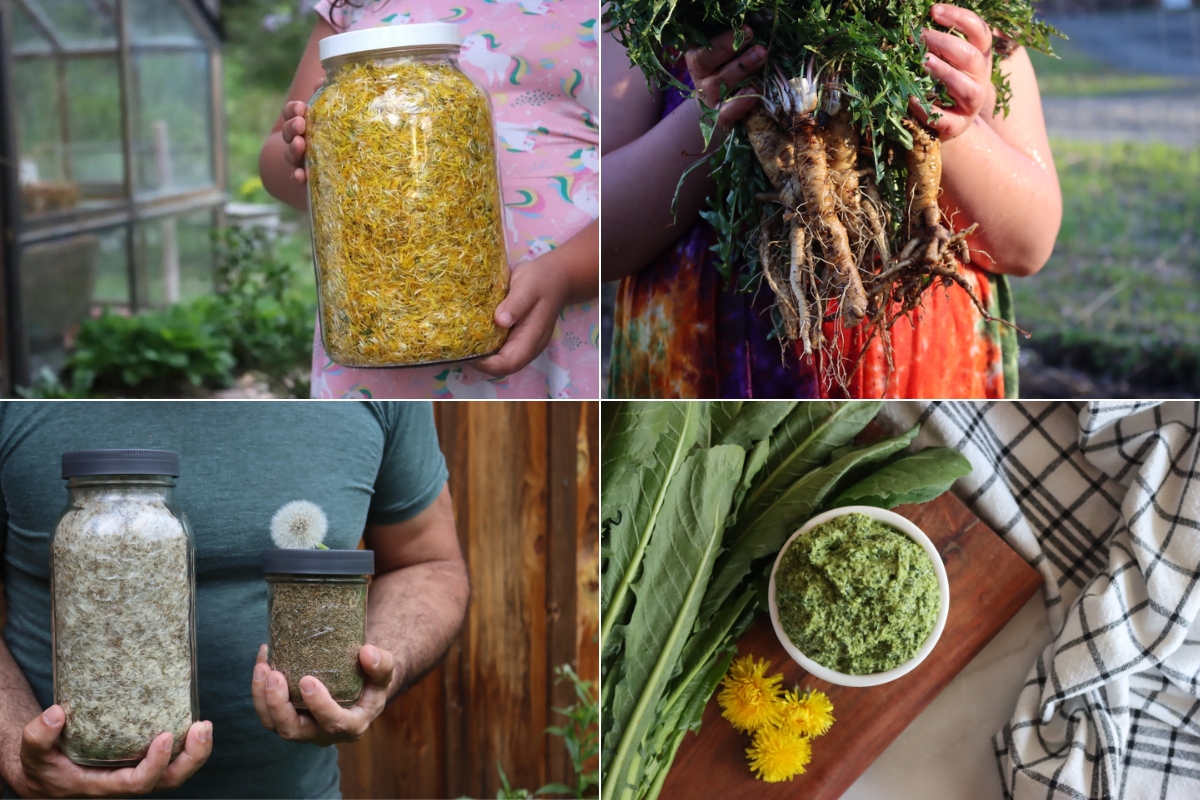
Identifying Dandelions
Dandelions are generally easiest to identify when in flower.
They have basal rosettes of leaves, hollow stems, and often have yellow to orange composite flowers. They’re also well known for their fluffy, spherical seedheads.
Dandelion Flowers
Dandelion flowers form on a single flower stalk and are composite flower heads composed of many ray florets. The flower heads may be yellow, orangish, white, tan, pinkish, or any combination thereof.
The vast majority of dandelion flowers are a sunny yellow color, and the other colors are rare mutations or cultivated varieties the you won’t see wild in nature, like the Japanese White Dandelion (Taraxacum albidum) and the Pink Dandelion (Taraxacum pseudoroseum).
Flower colors beyond a sunny yellow to orange are the exception, so we’ll stick with bright yellow to orange as a rule. Typically, the flowerheads are ¾ to 2 inches in diameter.
The flowers open during the day and close at night. Interestingly, if they’re not pollinated, Dandelions may reproduce asexually apomixis, where the seeds will result in offspring that is genetically identical to the parent plant. So, while bees may like dandelions, the dandelions themselves don’t need the bees to reproduce.
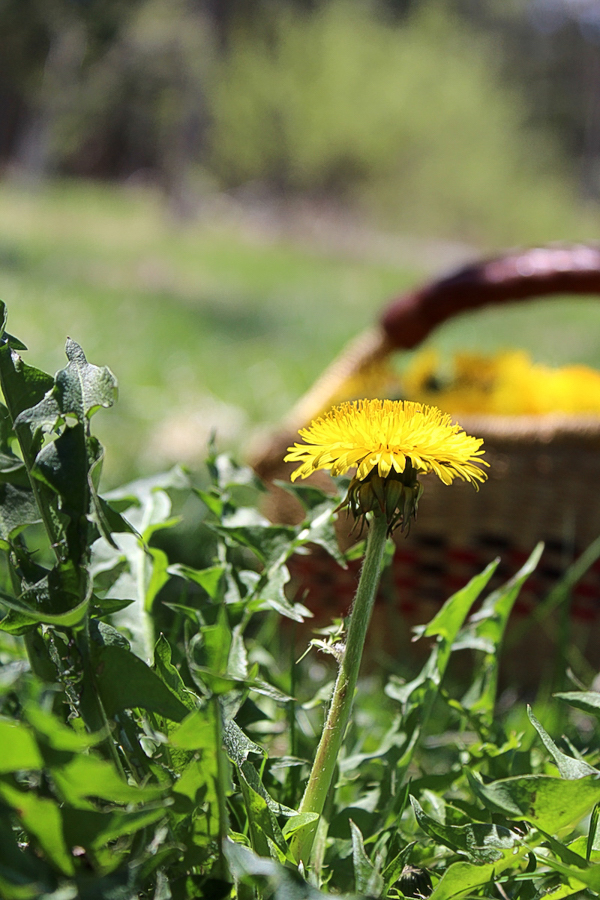
Most dandelion plants produce dozens of flowers each spring, all from a single basal rosette.
Each dandelion flower grows on a single stalk originating from the base. The stalks do not branch, which is one way to tell them apart from look-alike plants.
You may see many dandelion flowers all in one cluster, but each one grows on its own stalk from the center of a basal rosette of leaves at ground level.
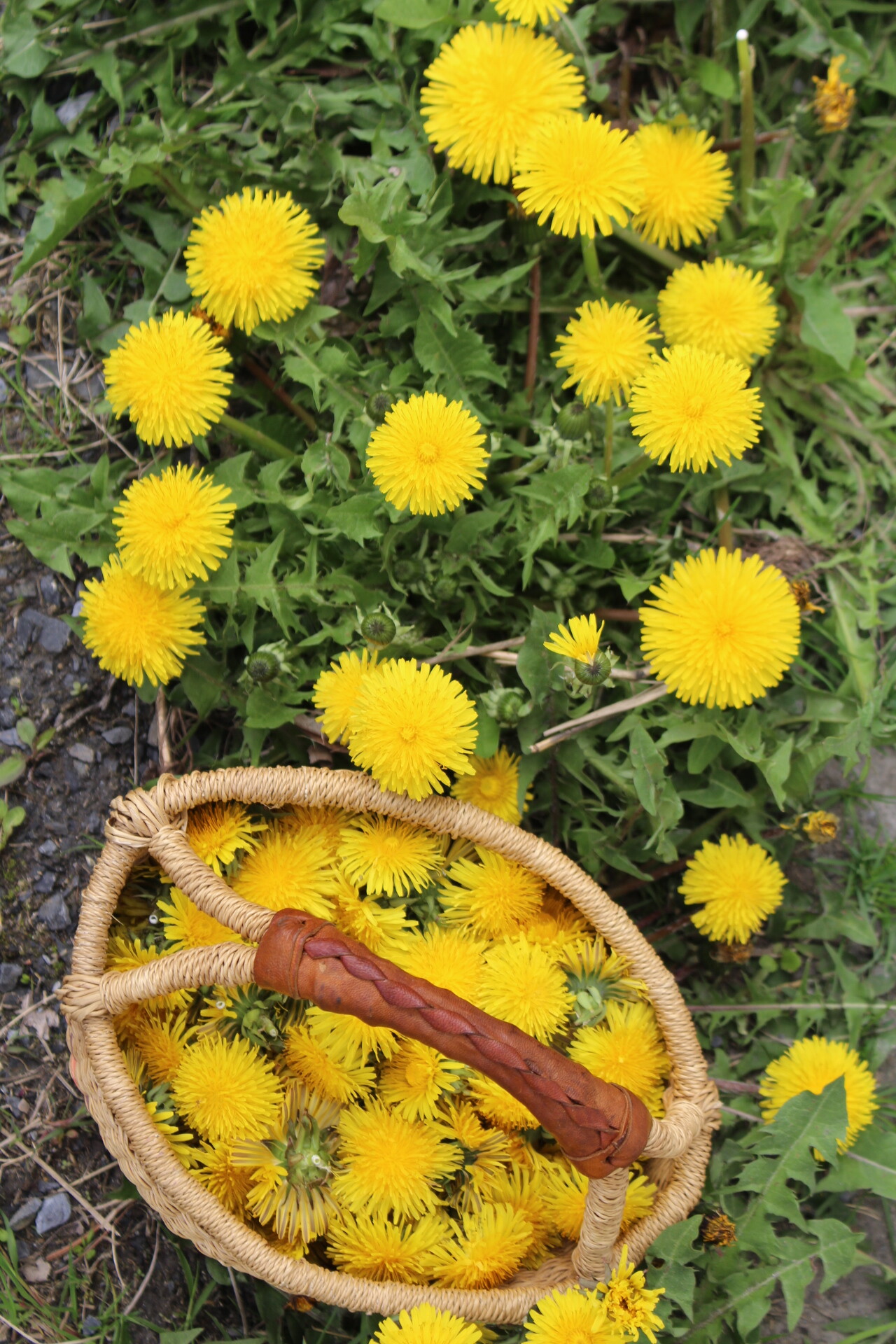
Dandelion Leaves
Dandelion leaves grow in basal rosettes with no leaf-bearing stems. That means they grow directly out of the top of the root and radiate out in a circle from there. They’ll sometimes stick up a bit, but most often, they’ll form a circle (called a basal rosette) on the ground. They do not have “stems” beyond their flower stalks.
(Many of their look-alikes do have stems, and the leaves grow in the stems, so this is another way to identify them.)
The individual leaves may grow 2 to 16 inches in length, growing much larger in rich soils with high fertility. You’ll only really see those tiny leaves in sidewalk cracks or marginal locations. Typically, the leaves are narrower at the base and wider towards the tip.
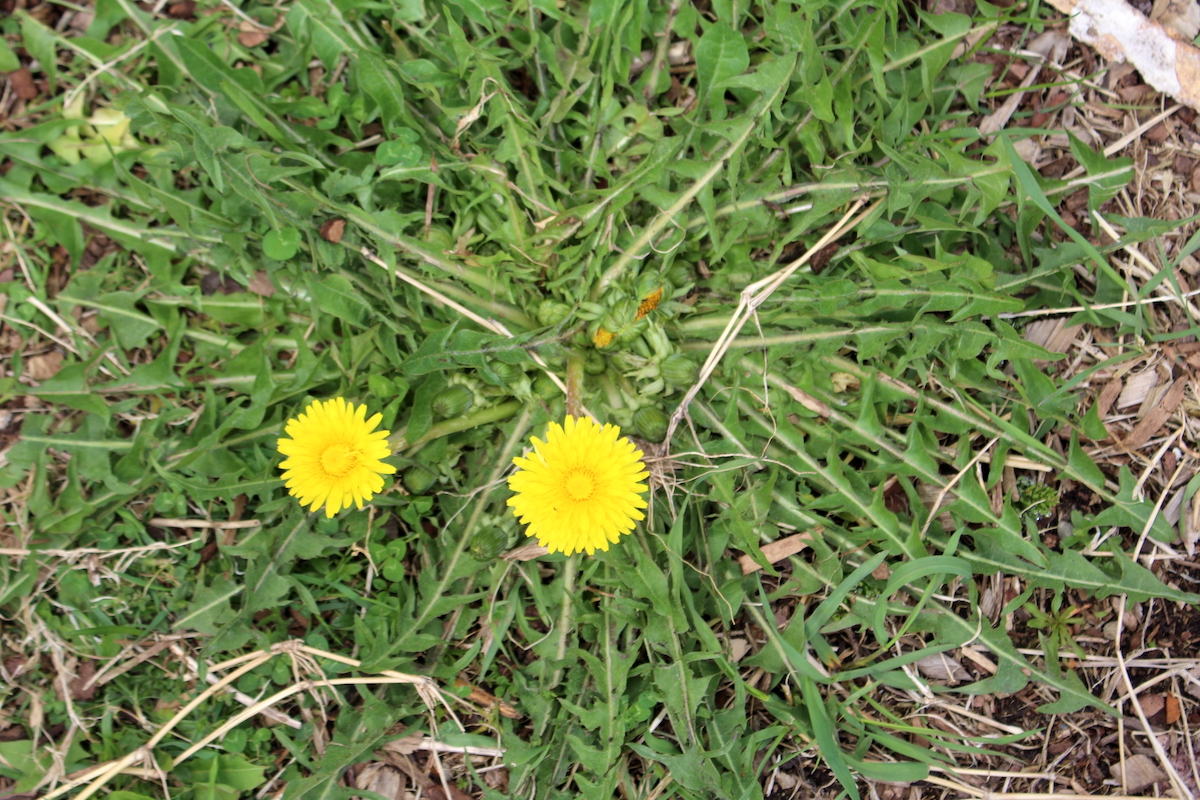
The edges of the leaves are lobed, with the lobes usually pointing backward toward the base. The size, shape, and number of lobes are extremely variable and differ on individual plants, species, or habitats. Generally, leaves growing in the shade will have shallower lobes.
The leaves are typically green though they may be tinged reddish or purplish. Typically the midrib is lighter than the rest of the leaf. When broken, the leaves exude a white latex sap.
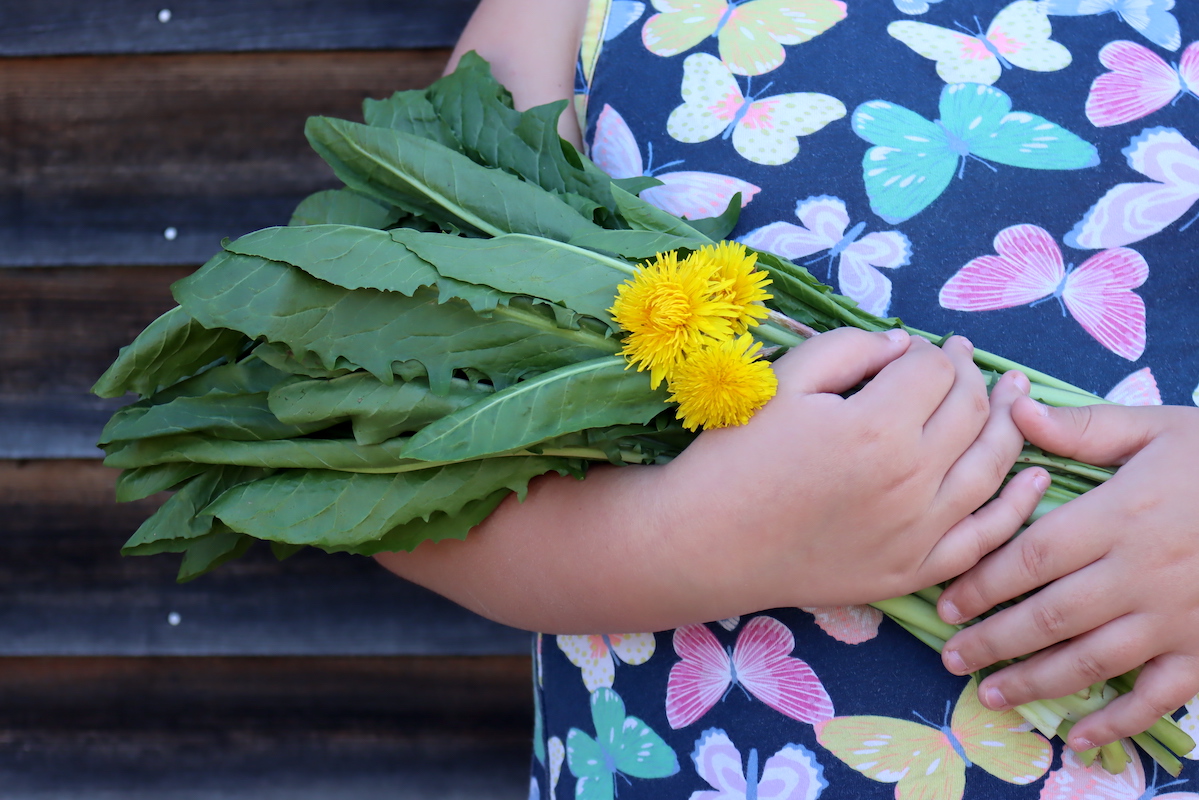
Dandelion Stems
Dandelions produce flower stems from the center of their crowns. These stems are hollow, leafless, unbranched, and generally 4 to 18 inches in height, though they may reach slightly higher, especially in full shade.
The stems may be pure light green, especially in shady areas, or be tinged with red. They may be hairless and smooth or covered with fine white wool. When broken, the stems exude a white latex sap.
So key takeaways here, the stems are:
- Hollow Stems
- Unbranching Stems
- Leafless Stems
- Stems exude a milk-white latex sap
- Stems are 4 to 18 inches tall, but often around 6 to 8”
None of their look-alikes have all these features, so that’s another good way to identify dandelions. (Wild lettuce, for example, has hollow stems and exudes white latex, but their flower stalks are branching, have leaves, and grow much higher than 4 to 18 inches.)
Dandelion Roots
Dandelions form large edible taproots. In the first year, a single dandelion rosette will have a long, slender taproot beneath it that resembles a parsnip. The flesh of this root is generally uniformly light-colored.
If grown in light, sandy soil without obstructions, the roots can grow to be several feet in length.
This root (below) is a one-year-old dandelion that sprouted up in our 2 feet deep garden raised beds. It hid among the strawberries for a season, long enough to grow this impressive tap root. Note the light color, which is one of the ways you can tell the age of this plant. (The root was also tender, which you can’t see from the picture.)
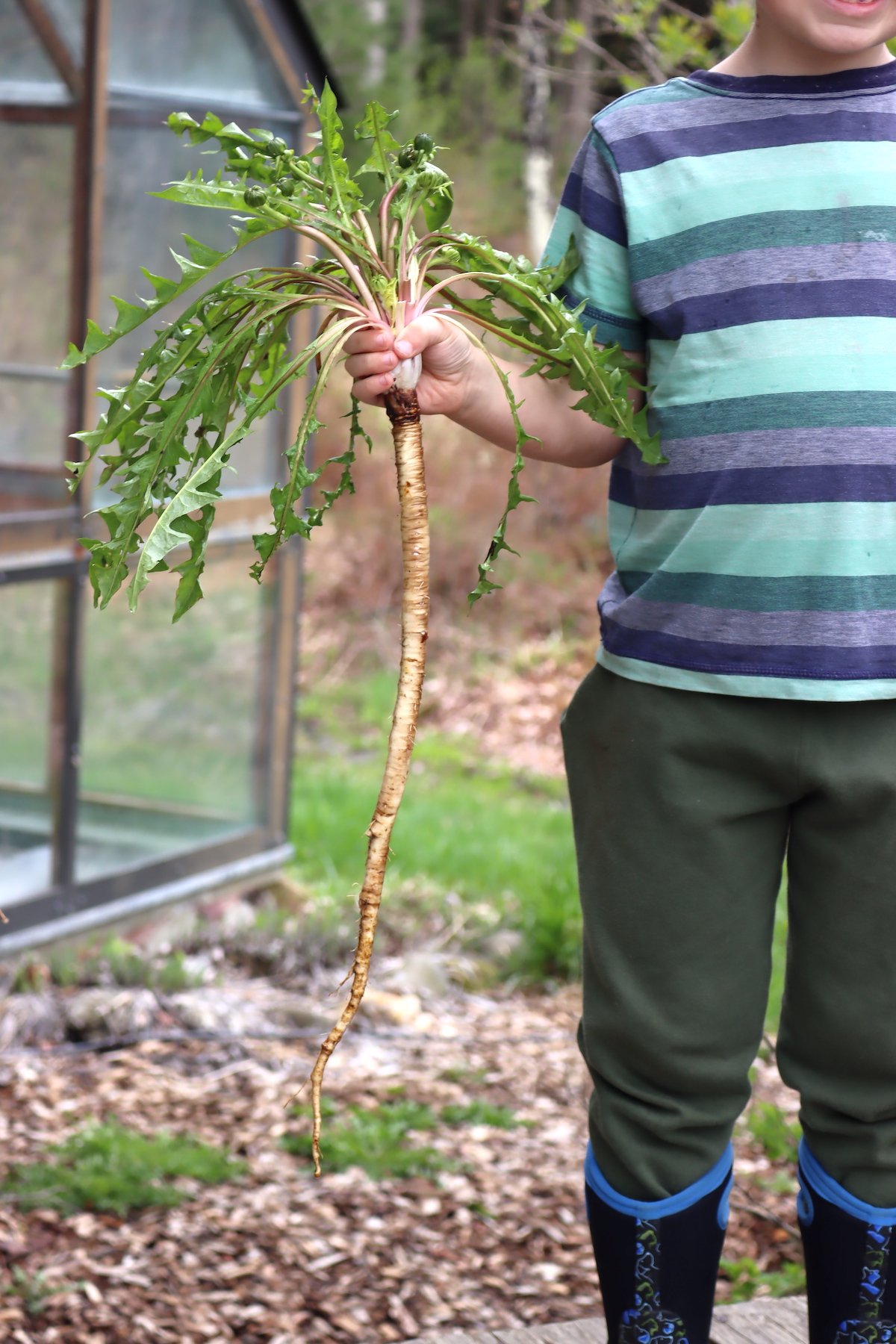
In later years, the root surface begins to darken and toughen. The root also often develops a darker-colored core.
As they age, the roots often split lengthwise and form branches. The top of the root may form multiple heads and crowns.
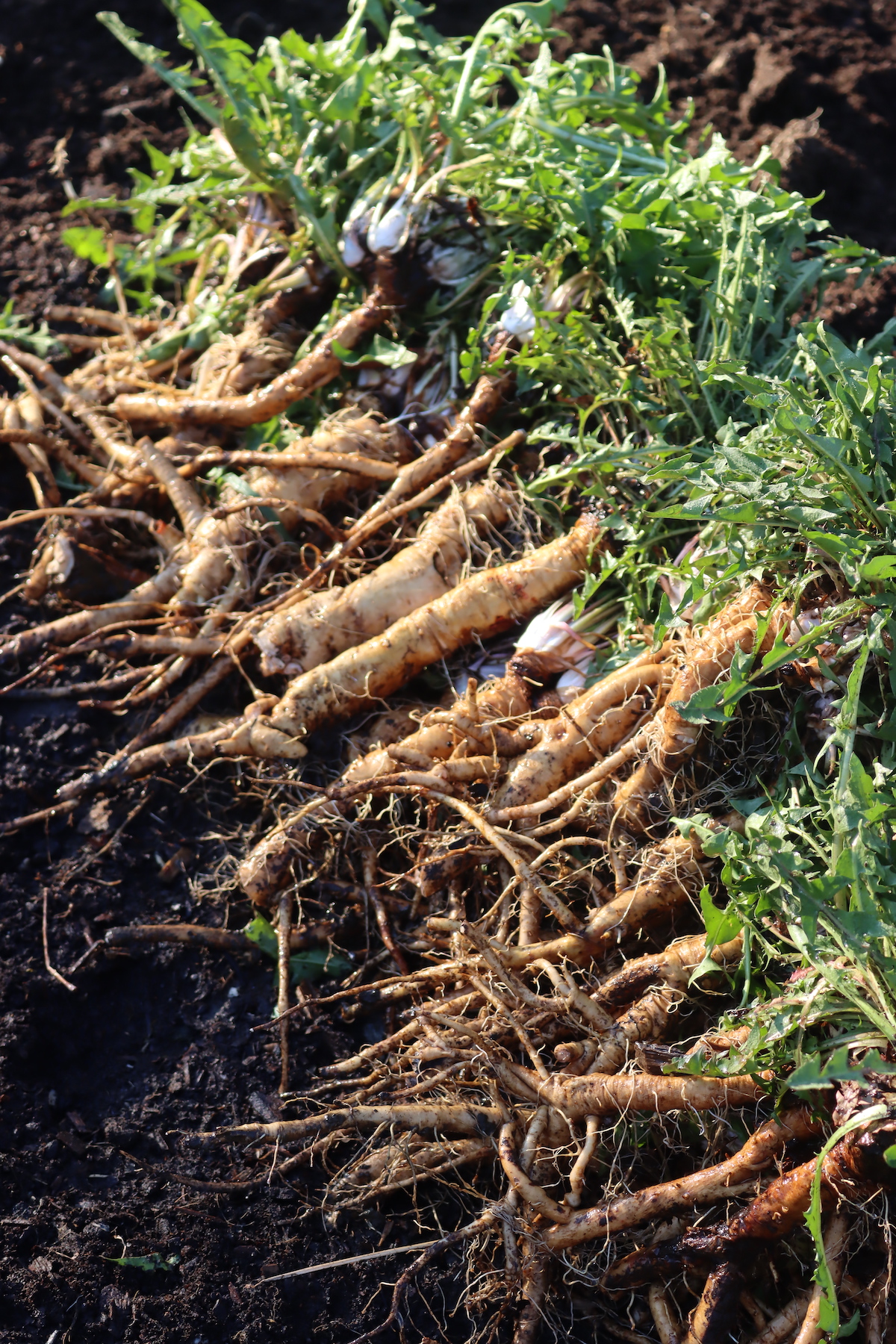
Dandelion Seeds
The flowers quickly give way to spherical, fluff white seed heads composed of parachuted, light-colored seeds.
Each seed or achene has a stalk attached to a pappus or parachute-like cluster of fine hair-like material, allowing the seeds to disperse long distances on the wind.
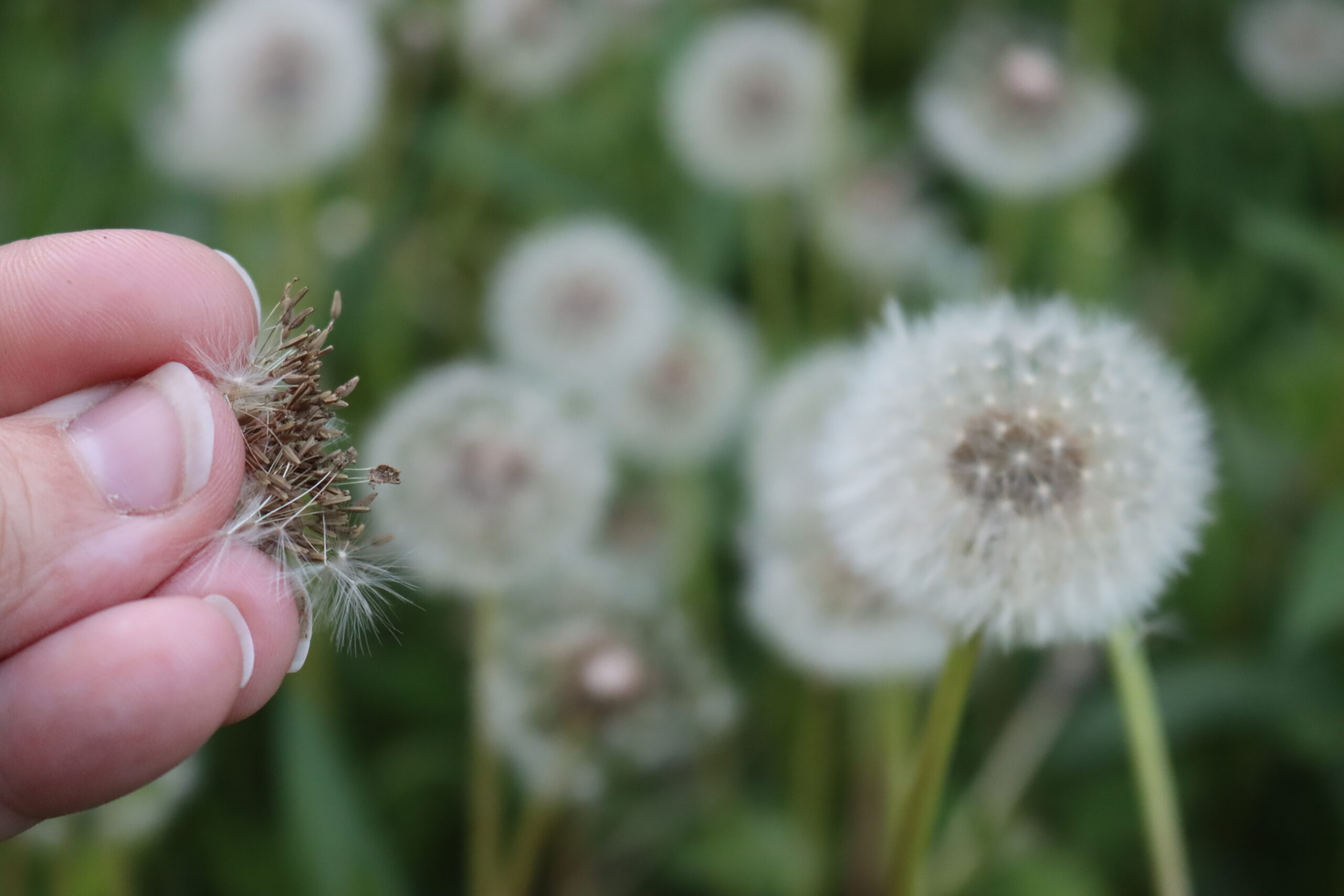
Many dandelion look-alikes also have a similar wind-dispersed seed head, but they look different.
In the picture below, you’ll see a dandelion seed (right) head next to a coltsfoot seed head (left). While similar at a glance, they’re quite different if you’re really looking closely.
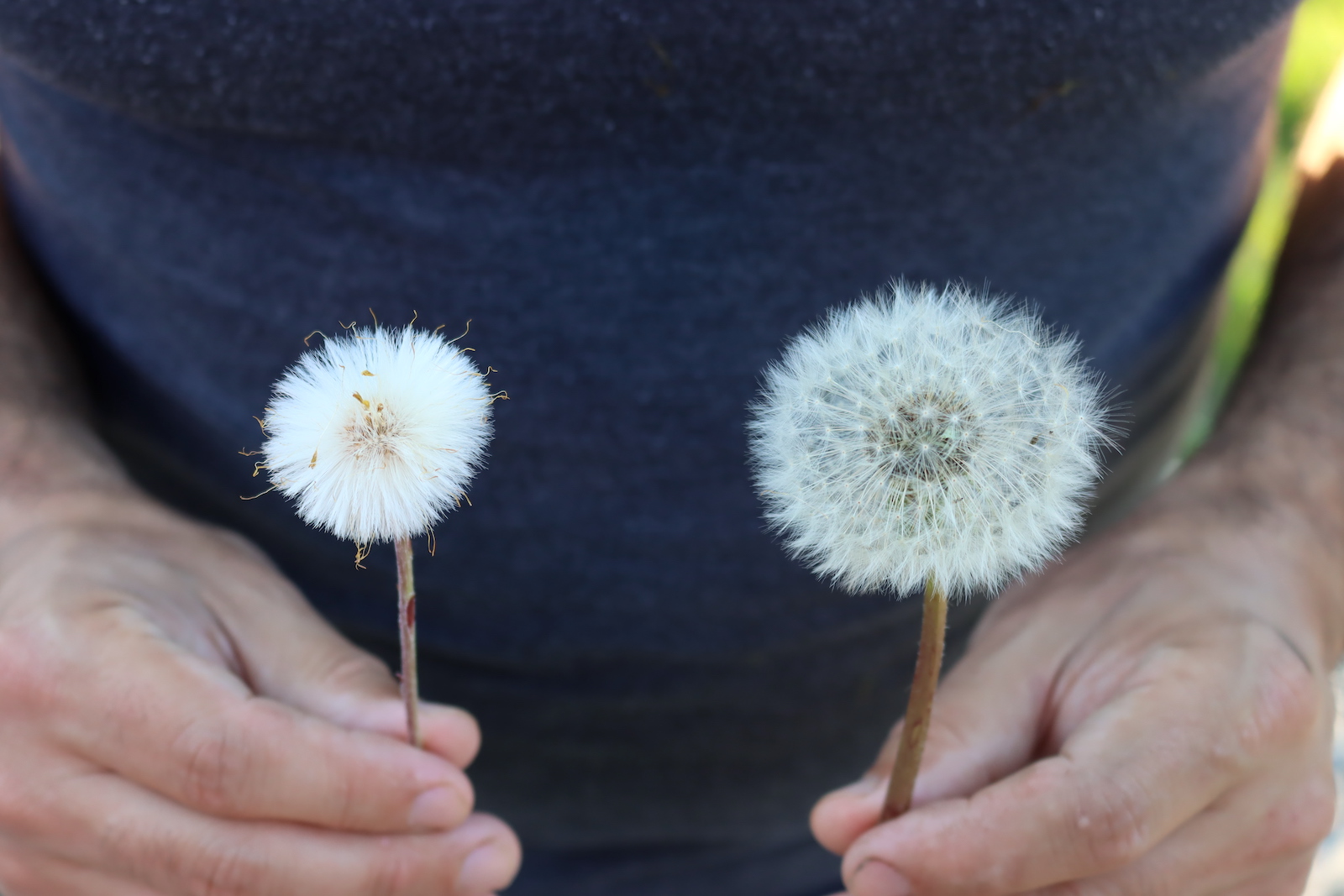
Dandelion Look-Alikes
Now that you know the main identification characteristics of dandelions, I’ll take you through each of their look-alikes, starting with the most commonly confused species. Here is a list of common dandelion look-alikes:
- Coltsfoot (Tussilago farfara)
- Cat’s Ear (Hypochaeris radicata)
- Fall Dandelion (Scorzoneroides autumnalis)
- Narrowleaf Hawksbeard (Crepis tectorum)
- Meadow Hawkweed (Hieracium caespitosum)
- Rough Hawkbit (Leontodon hispidus)
- Sow Thistle (Sonchus spp.)
- Wild lettuce (Lactuca virosa)
- Prickly Lettuce (Lactuca serriola)
- Beach False Dandelions (Agoseris apargioides)
- Mountain Dandelion (Agoseris glauca)
- False Prairie Dandelions (Nothocalais troximoides)
Of all the dandelion look-alikes on this list, coltsfoot, cat’s ear, and fall dandelion are the most commonly confused with true dandelions. They’re all incredibly common all over the US, and they’re easy to confuse with real dandelions if you’re not paying attention.
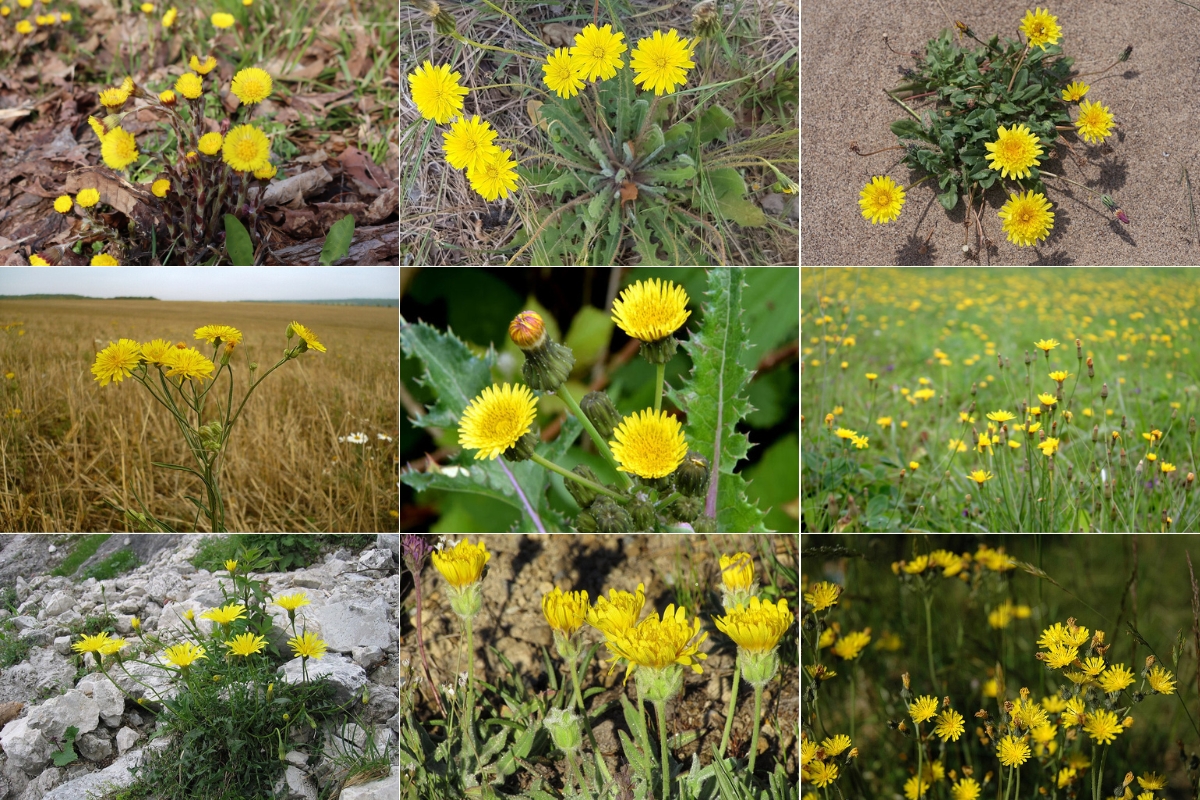
Coltsfoot (Tussilago farfara)
Probably the most commonly confused dandelion-lookalike is coltsfoot. It’s incredibly common and grows in many of the same locations where you can find dandelions. The plants thrive on poor soils and do well along roadsides and heavily trafficked paths.
Coltsfoot actually blooms well before the first dandelions of spring, and people fall for the myth that dandelions are the first flowers of spring. Here in Vermont, we’ll see the first coltsfoot blossoms as soon as the snow melts, sometimes as early as the beginning of March. The first dandelions won’t bloom unitl mid-May. (In warmer locations, their bloom periods are closer together, and they may only start a week or two apart.)
The bloom periods often overlap, and it’s not uncommon to find coltsfoot and dandelions growing side by side in the spring.
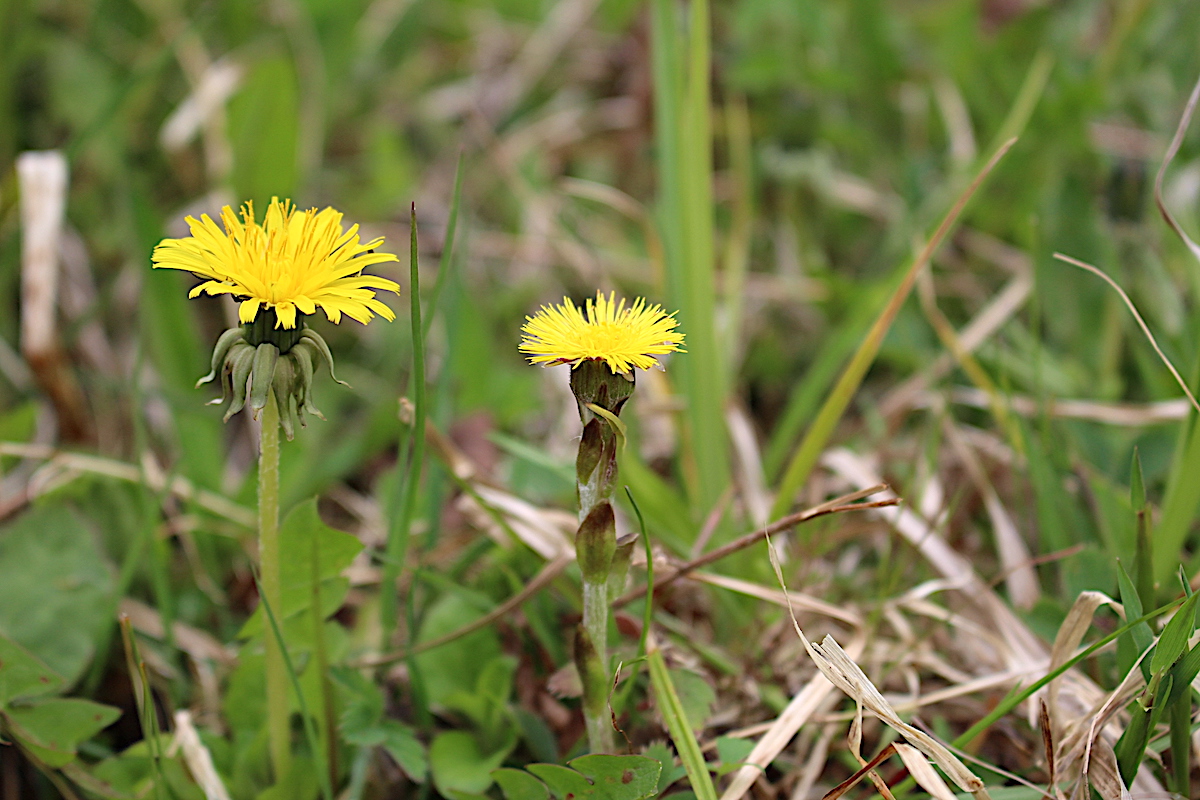
Bright yellow coltsfoot flowers come up without leaves, and the leaves will appear later in the season. (That’s one reason it sometimes goes by the old-time name “The son before the father.”)
They tend to grow in dense patches, carpeting roadsides in spring.
They are edible, at least traditionally. Coltsoot is used by herbalists for short periods as a cough remedy, and the leaves were burned for salt.
We make coltsfoot wine with its flowers, which is a light floral wine that’s similar to dandelion wine. It’s not the end of the world if you confuse coltsfoot for dandelion, though they don’t really taste anything alike.
(Be aware that some people react badly to coltfoot, especially those with liver issues. Coltsfoot tea has caused poisonings when taken for more than a week or two, especially in young people and infants with underdeveloped livers. Though it was used traditionally, this is one you want to be careful with.)
To distinguish Coltsfoot (Tussilago farfara) from dandelion, look for these clues:
- Coltsfoot flowers bloom before the leaves have formed, and have distinct disc florets and ray florets.
- Coltsfoot stems feature tiny, bract-like, scaly leaves.
- Coltsfoot leaves, which appear after the plant has flowered, are thought to resemble colts’ feet giving the plant its name. They are large rounded, or heart-shaped and may be slightly toothed.
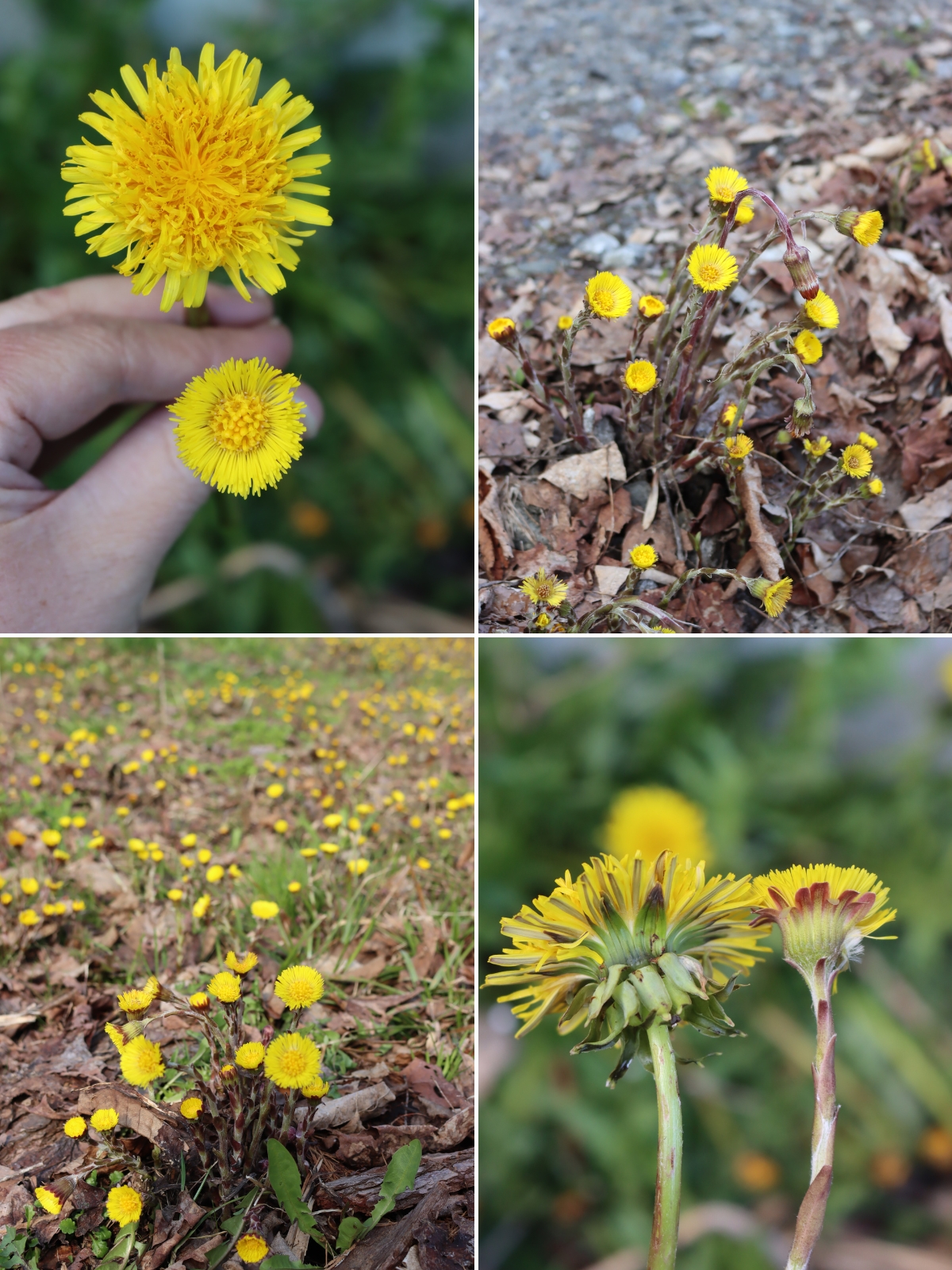
Cat’s Ear (Hypochaeris radicata)
A plant called Cat’s Ear (Hypochaeris radicata) looks even more like dandelion than coltsfoot, so it’s also confused with dandelions. These are less common than coltsfoot and dandelions, but they also sometimes carpet fields each spring with bright yellow blossoms. They grow all over the US, and I see plenty of “dandelion recipes” with these in the photos.
Here’s how you tell the difference between Cat’s Ear (Hypochaeris radicata) and dandelions:
- Cat’s Ear leaves are hairy with rounded lobes.
- Cat’s Ear has tough, wiry stems that are not hollow.
- Cat’s Ear usually has multiple flowers per stem.
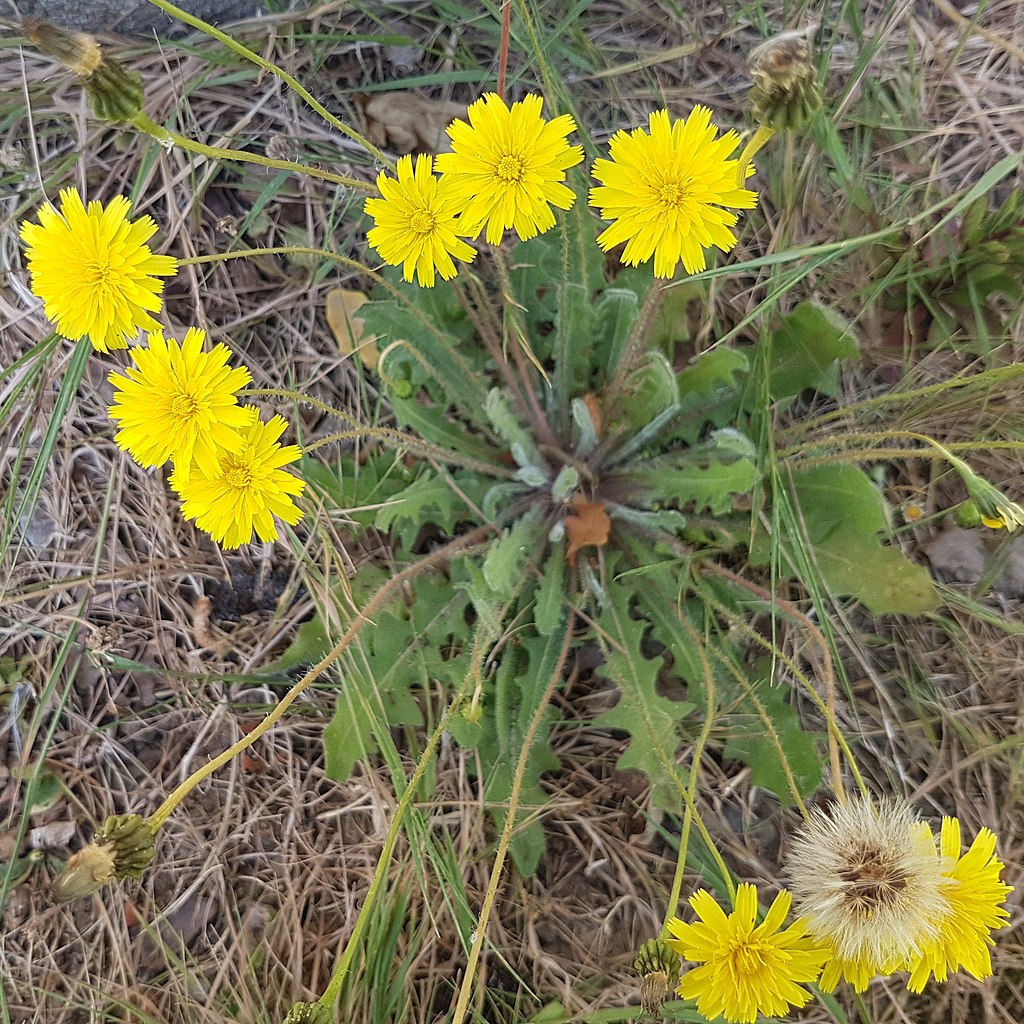
Fall Dandelion (Scorzoneroides autumnalis)
Either called Autumn Hawkbit or Fall Dandelion (Scorzoneroides autumnalis), these small yellow flowers bloom in the autumn months. They’re similar in bloom, but the flower stems are branching, and they’re not hollow.
These are just as common as dandelions, and you’ll see whole fields of them blooming in late summer and early fall.
Take a close look, and you’ll see each blossom is on a thin stem that branches and supports multiple flowers and flower buds. Dandelions do bloom again in the autumn, though not quite as intensely as in the spring, so you will sometimes see these plants blooming side by side.
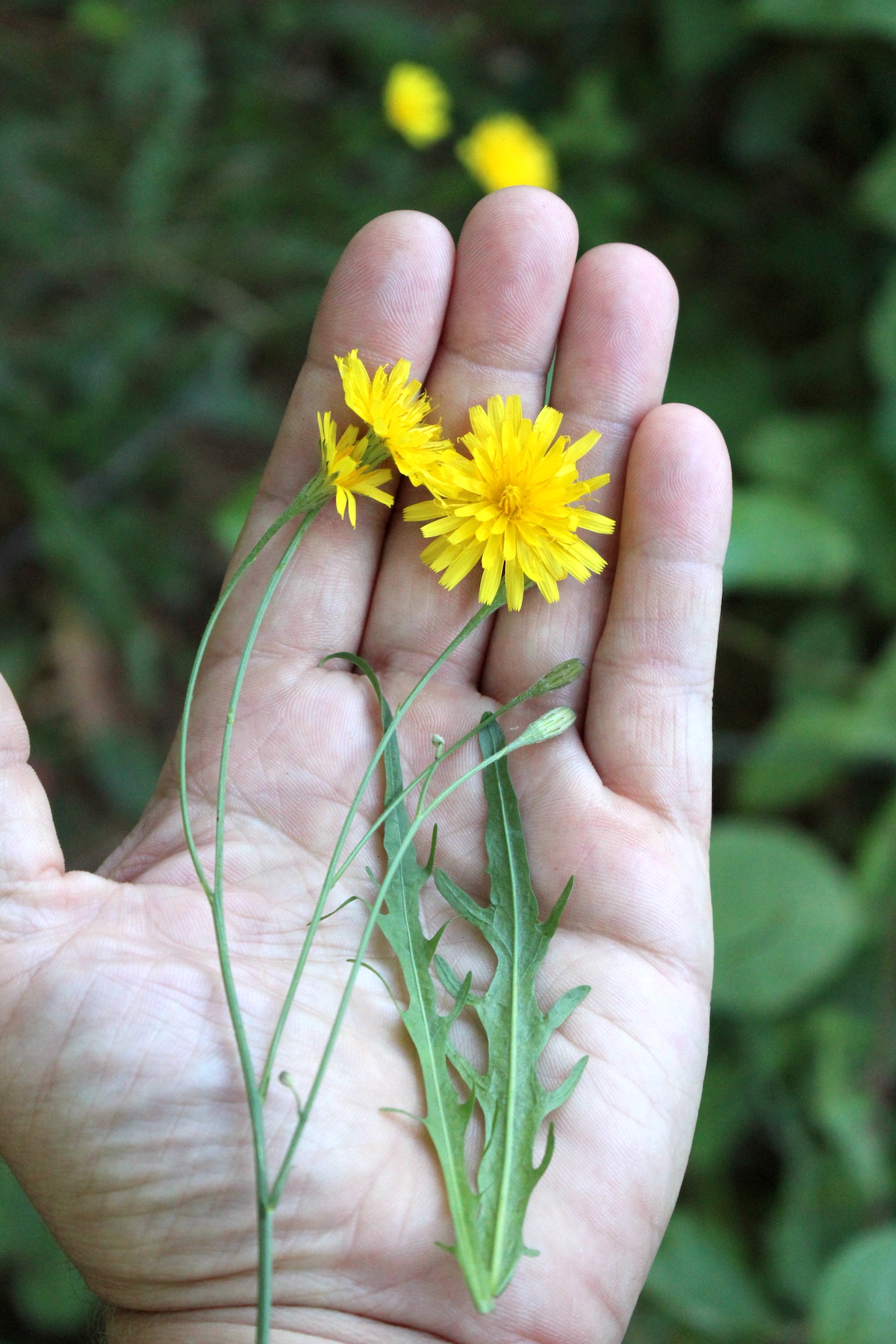
Autumn hawkbit gets its name because birds love the blossoms. Sometimes, it’s called “Hawkeye” because there’s an old wives’ tale that says that hawks get their good vision from eating the flowers.
Though birds love it, it’s not considered edible for humans. It’s not explicitly “toxic,” but it’s not something you want to eat either. Luckily, it’s not tasty to our palates, so you’ll figure out your mistake pretty quickly.
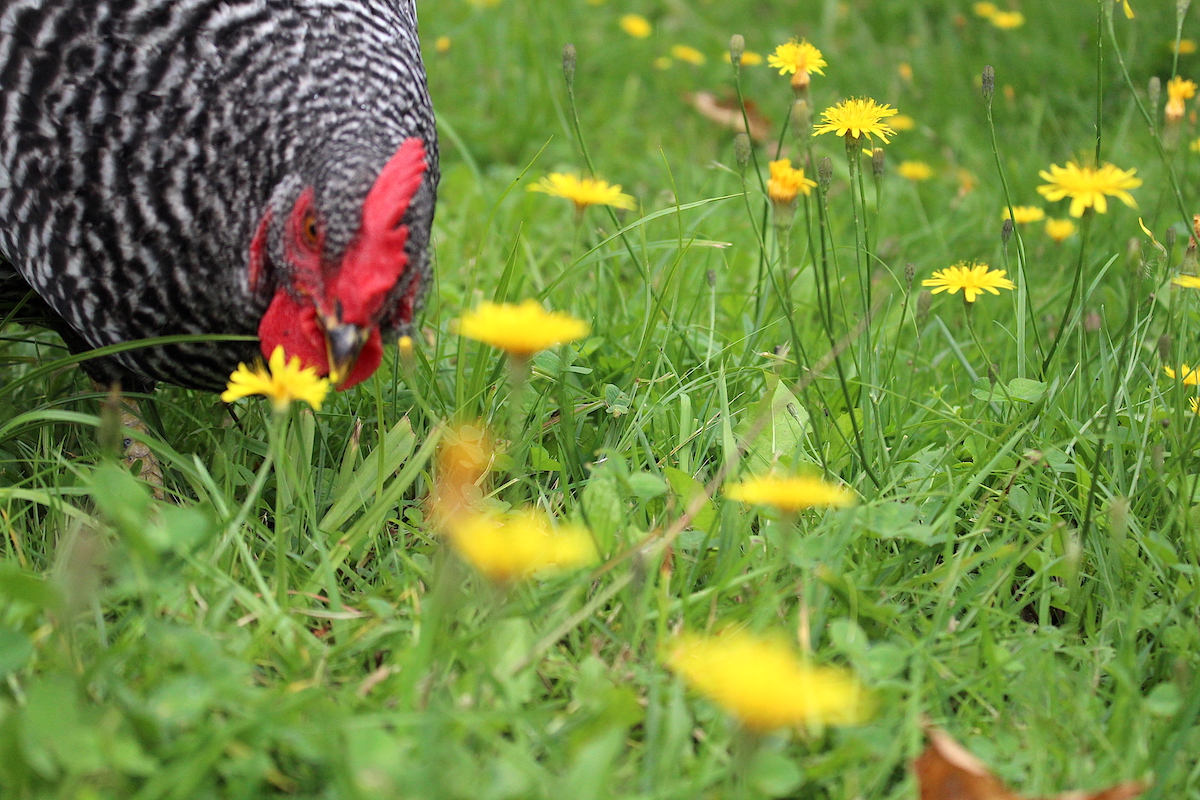
You can tell dandelions apart from the look-alike Autumn Hawkbit (Scorzoneroides autumnalis) in the following ways:
- Autumn Hawkbit has wiry, branched stems that branch into 2 to 5 branchlets, each with an individual flower.
- Autumn Hawbit leaves are typically smaller and often slightly hairy.
- Autumn Hawbit flowers are typically smaller and flatter in profile.
- The seeds are light brown and are attached directly to the pappus rather than being stalked.

Other Hawk Weed Type Flowers
Beyond Autumn Hawkbit, there are quite a few other common similar flowers that go by similar names. Though, they are all different species and have their own identification characteristics.
You can differentiate Narrowleaf Hawksbeard (Crepis tectorum) from Dandelion in the following ways:
- Narrow Hawksbeard stems are branched, mostly ridged, and covered in stiff, short hairs.
- The stems branch from the upper leaf axils to form clusters of up to 20 flowers.
- Narrow Hawksbeard leaves grow up the stems.
- Narrow Hawksbeard’s basal rosette of leaves mostly withers away as the plant matures.
- Narrow Hawksbeard seeds are dark purplish brown.
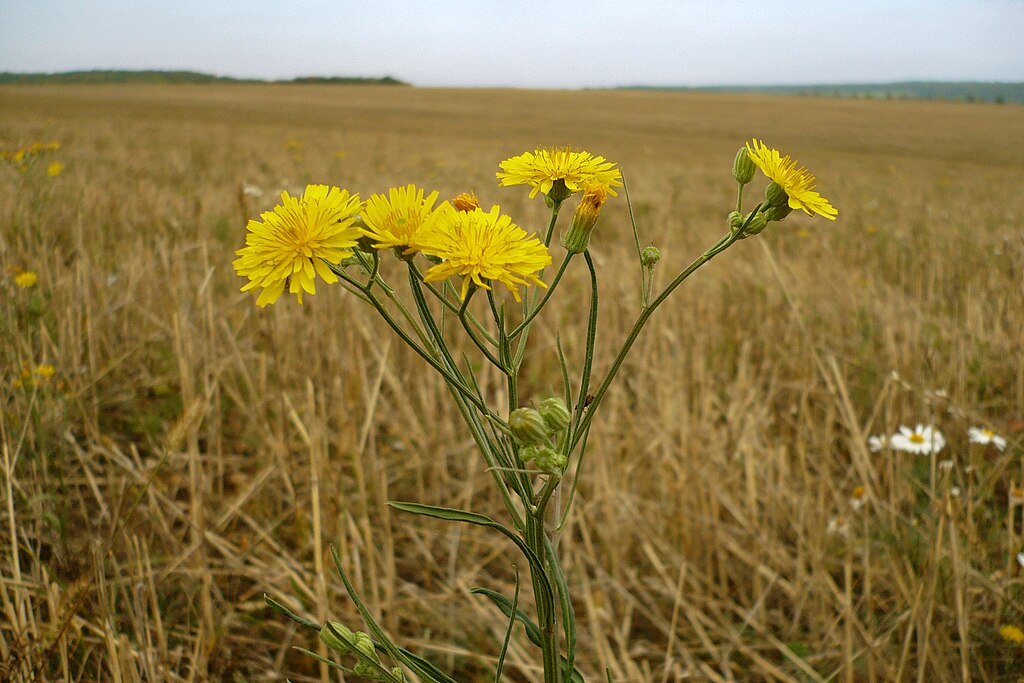
You can tell Meadow Hawkweed (Hieracium caespitosum) apart from dandelions in a couple of ways:
- The leaves, stems, and stolons of Meadow Hawkweed are conspicuously hairy.
- Meadow Hawkweed leaves are smooth or slightly toothed.
- Meadow Hawkweed has a basal rosette, and 10 to 30 flower stems, each producing 5 to 30 yellow flowers arranged in a flat-topped cluster.
- Meadow Hawkweed has a shallow, fibrous root system.
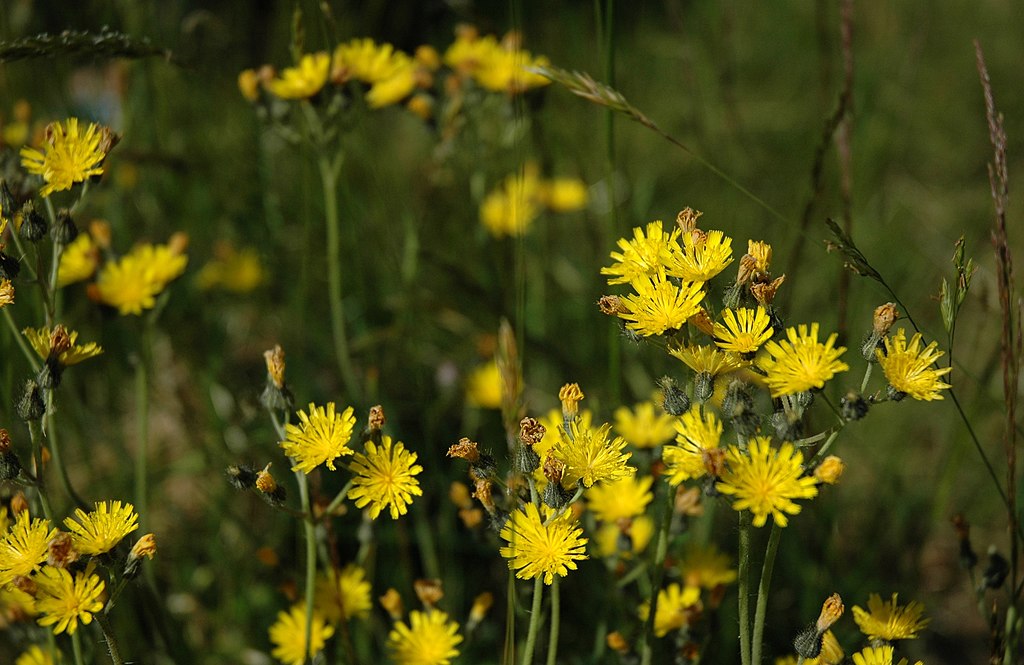
And Lastly, Rough Hawkbit (Leontodon hispidus) is different from dandelions in the following ways:
- Rough Hawkbit stems, buds, and leaves are covered in hairs that fork at the tips.
- Rough Hawkbit has a non-hollow, tough, wiry stem.
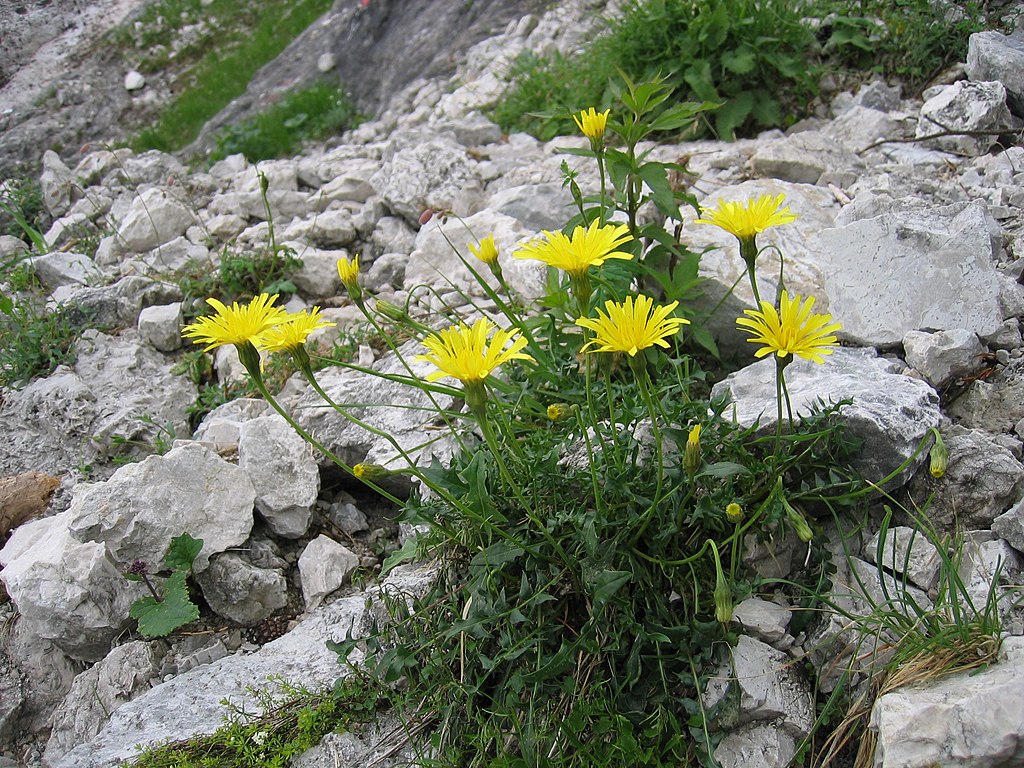
Wild Lettuce and Sow Thistle Look-Alikes
These dandelion look-alikes are all tall versions, which grow from 1 foot to 6 feet tall, and have central stalks with leaves attached. They also tend to have multiple flowers to a stalk.
It’d be quite a stretch to confuse these with dandelions, but still, I’ve seen people do it!
Dandelion may be mistaken for species of Sow Thistle (Sonchus spp.). Here are some key ways to differentiate the two:
- South Thistle stalks branch near the top and produce multiple flowers.
- Sow Thistle leaves grow up the flower stalk.
- Sow Thistle leaves are typically broadest near or above the middle.
- Sow Thistle leaves have spiny, prickly edges.
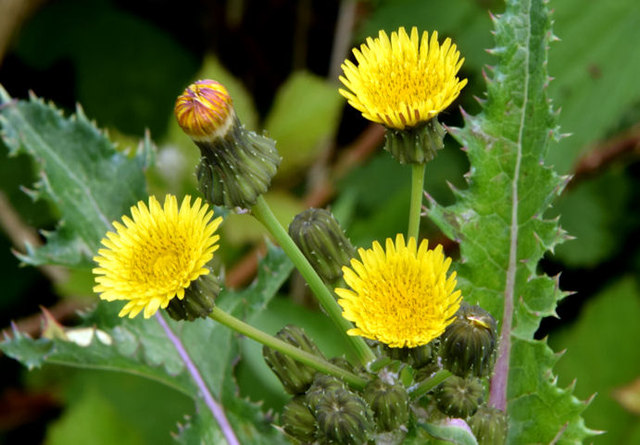
Another initially similar-appearing plant is Wild lettuce (Lactuca virosa). Here’s how to distinguish it:
- Wild Lettuce leaves have prominent hairs on the underside of the midrib.
- Wild Lettuce produces a large central stalk with leaves growing up it.
- Wild Lettuce may grow up to 6 feet in height, but is often much shorter like dandelions.
- Wild Lettuce has very small flowers, and they branch off a central flowering stalk.
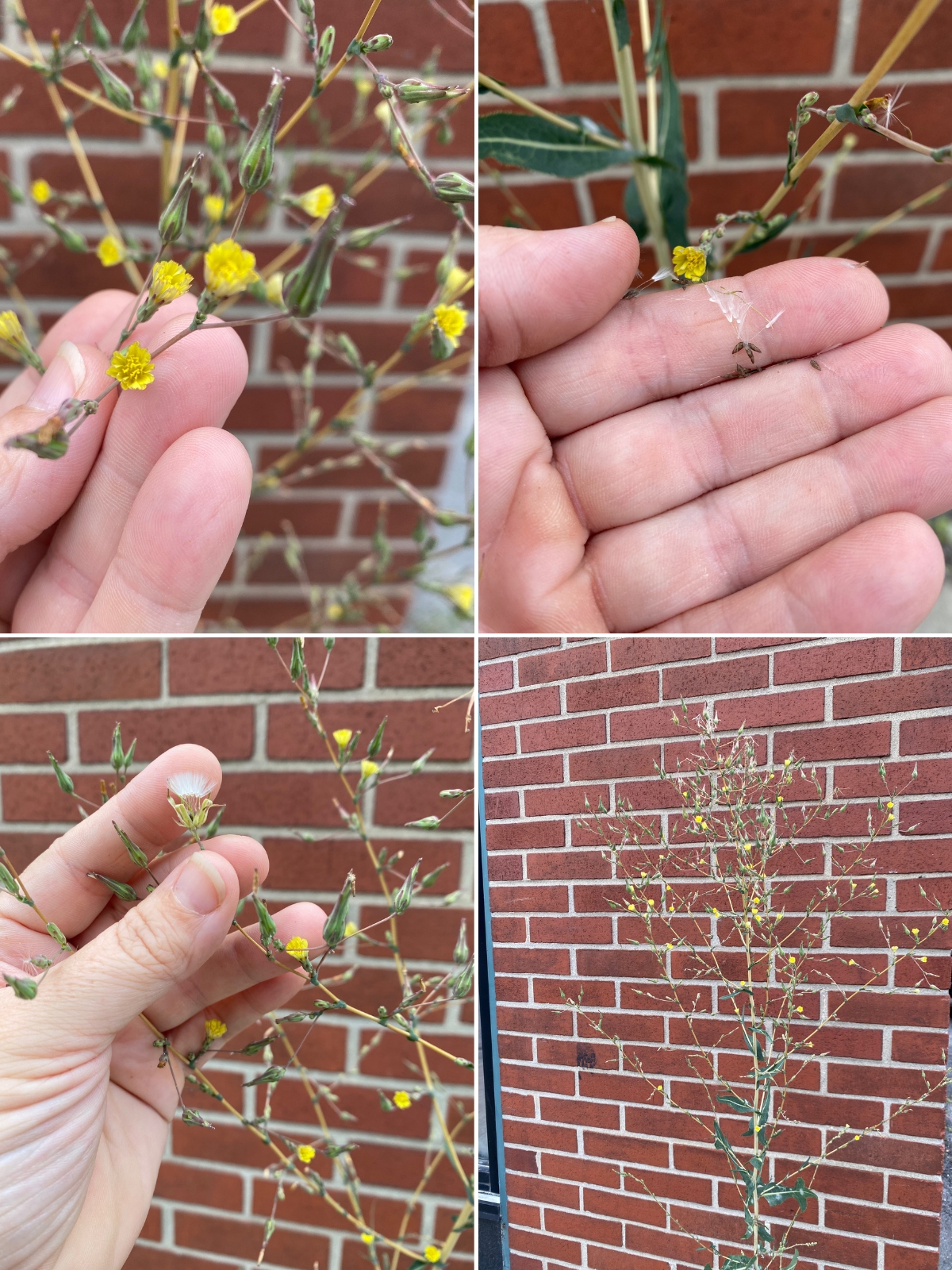
Dandelion can also be mistaken for another plant in the lettuce family, Prickly Lettuce (Lactuca serriola). It, too can be easily distinguished in the following ways:
- Prickly Lettuce leaves have prominent hairs on the underside of the midrib.
- Prickly Lettuce produces a large central stalk with leaves growing up it.
- Prickly Lettuce leaves have prickly edges.
- Prickly Lettuce may grow up to 6.5 feet in height, but is often much shorter like dandelions.
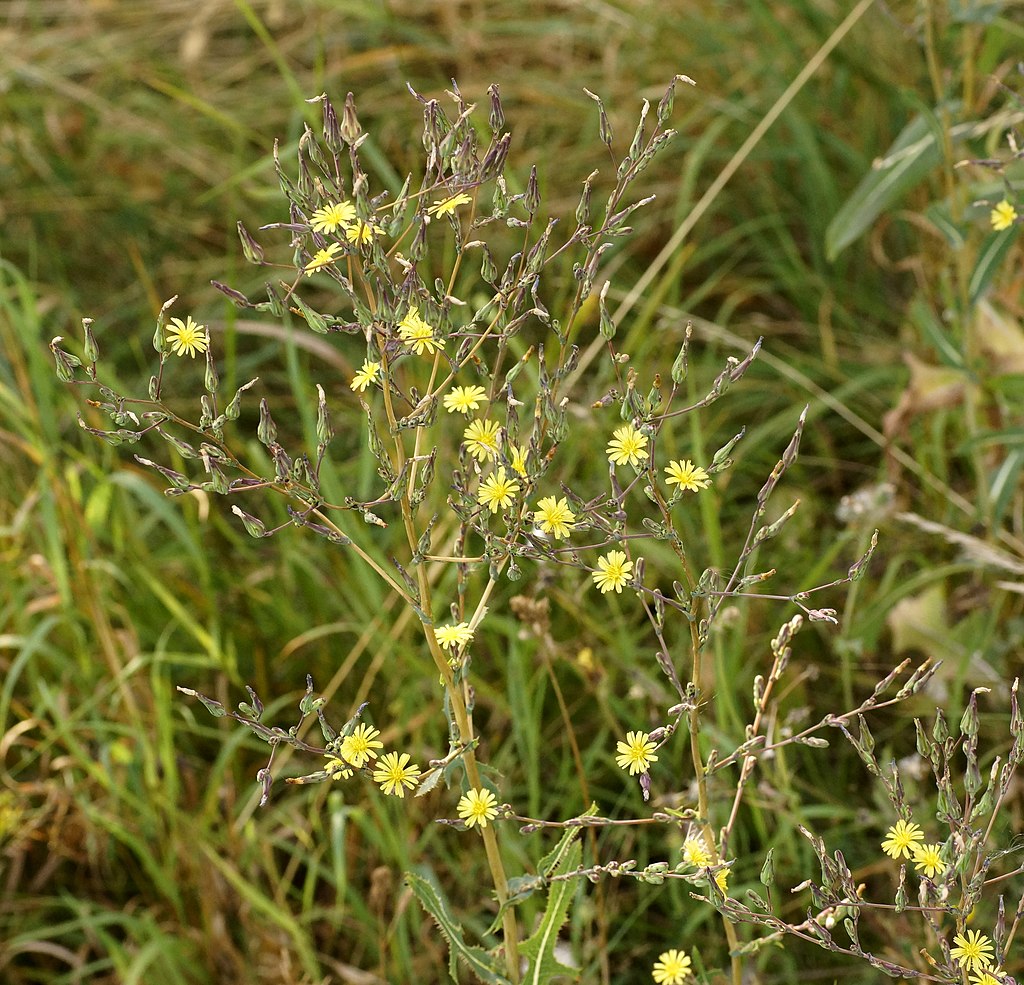
False Dandelions
These last two planst look quite a bit like dandelions, but they’re not all that common. They’re limited to specific geographic regions in the US and you’re not likely to find them carpeting your lawn. That said, if you live in California, you do need to watch for the False Beach Dandelion, and if you live in the prarie states or western mountains, you’ll want to keep an eye out for Mountain Dandelion and False Prairie Dandelions.
Dandelions can also be confused with Beach False Dandelions (Agoseris apargioides) which is not a true Dandelion or Taraxacum. You can differentiate it in the following ways:
- Beach False Dandelion grows on sand dunes.
- The stems of Beach False Dandelions often produce a milky orange sap when cut.
- The outer ray florets of Beach False Dandelions each have one purple line on their lower surface.
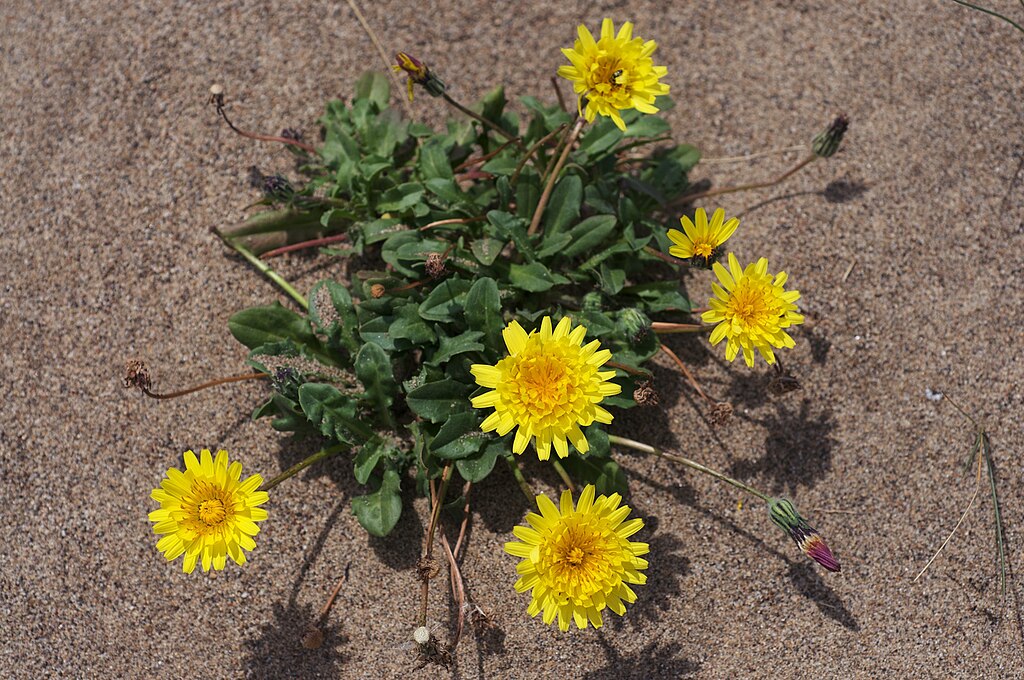
Similarly, Dandelion can be confused with another false dandelion, Mountain Dandelion (Agoseris glauca). It can be distinguished in the following ways:
- Mountain Dandelion leaves are long, strap-like, and vertical.
- Mountain Dandelion leaves are waxy, bluish-green to dark green or red-purple, and frequently have a red-purple midrib.
- Mountain Dandelion stems may be slightly hair, and the flower buds are hairy.
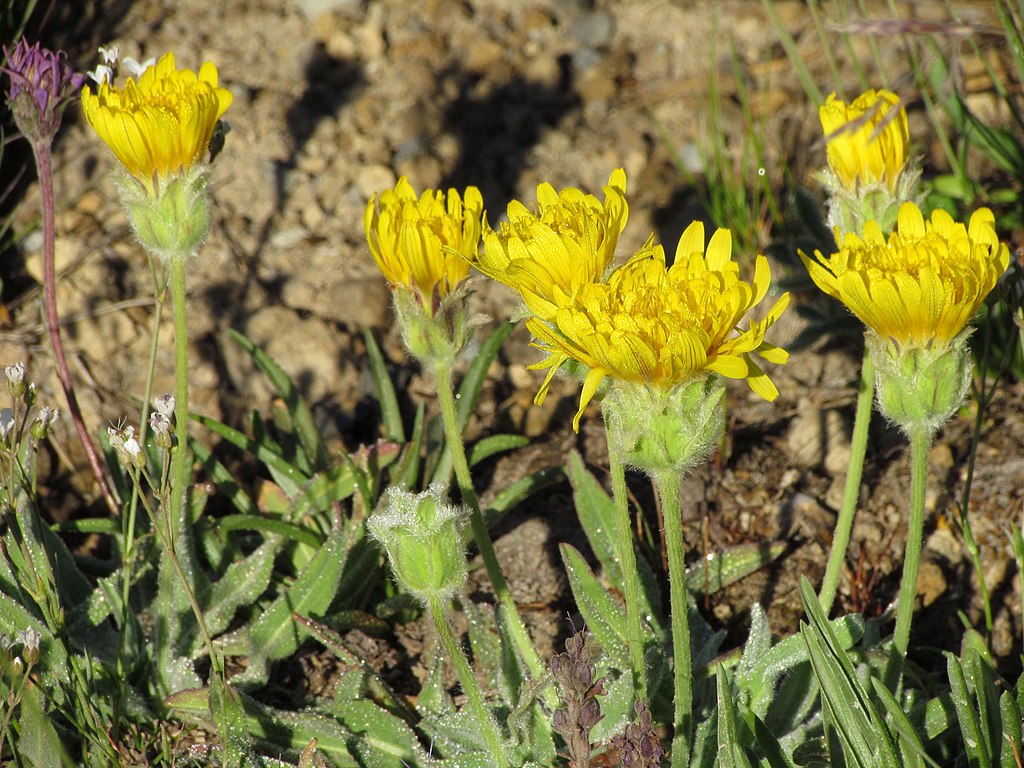
Finally, Dandelions may be confused with False Prairie Dandelions (Nothocalais troximoides). It differs in a few ways:
- False Prairie Dandelion leaves have crinkled, wavy, or undulating leaf margins.
- False Prairie Dandelion flowerheads have many ray florets but no disc florets.
- False Prarie Dandelion produces a wooly stem.
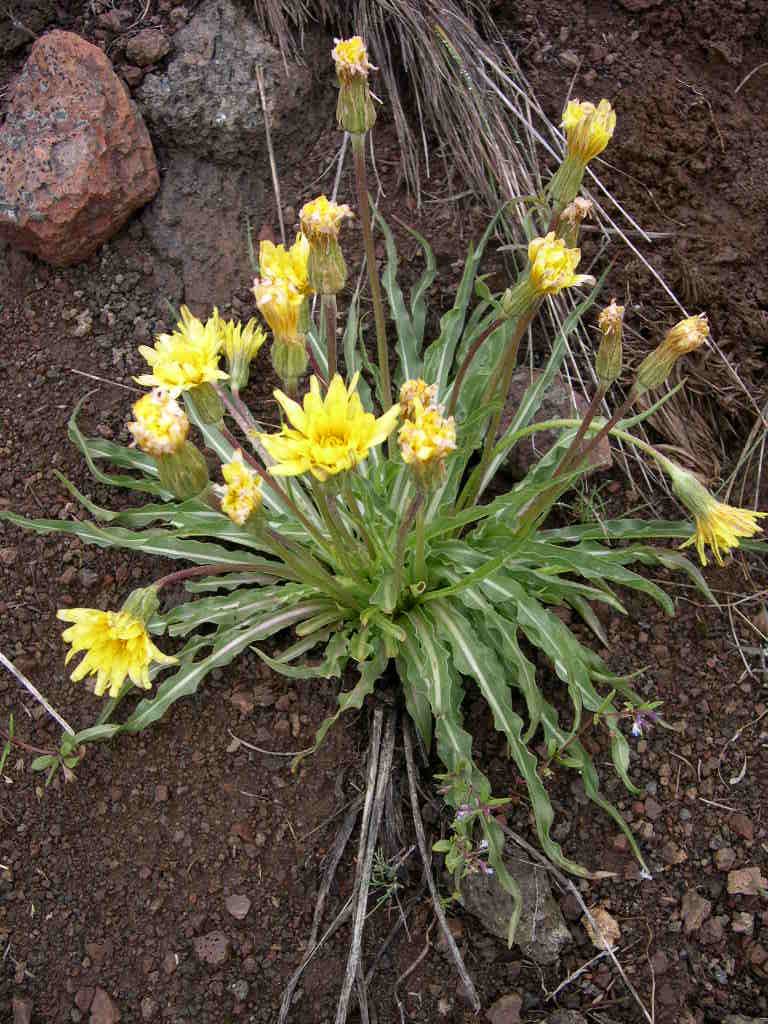
Have I missed any? Are there any other plants that you see people confuse with dandelions? Leave me a note in the comments!
Plant Identification Guides
Looking for more wild weed identification guides?
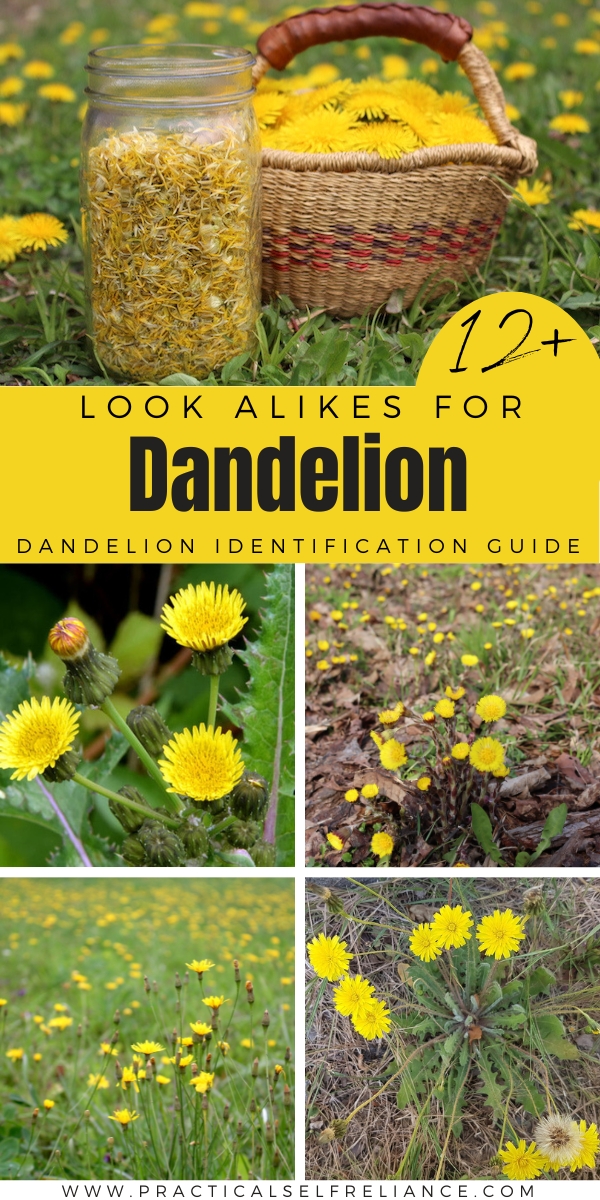
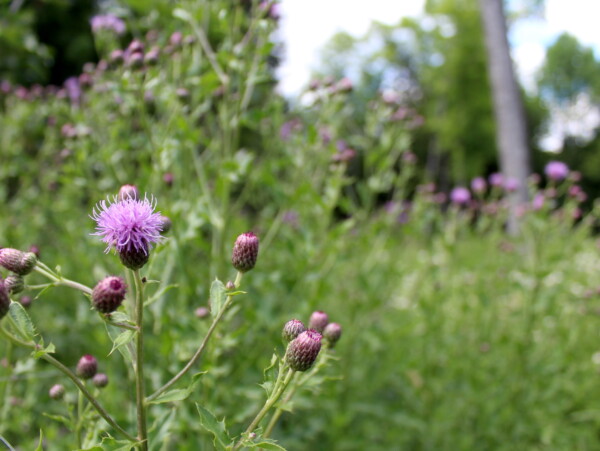
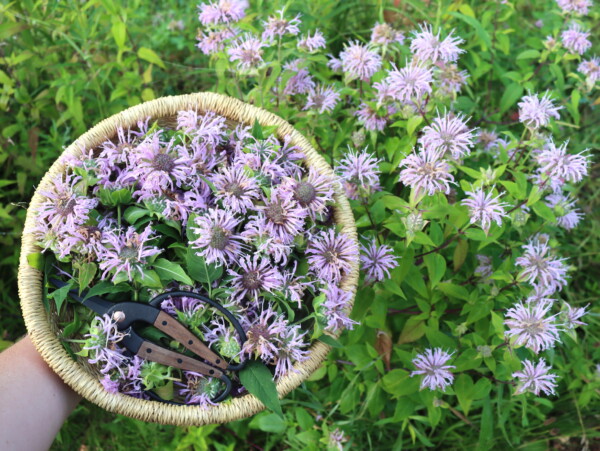
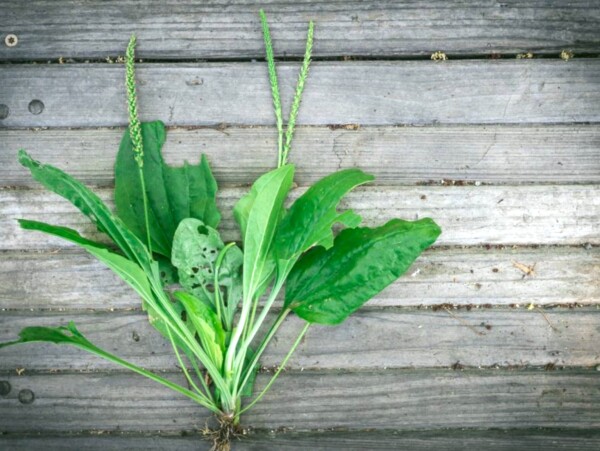
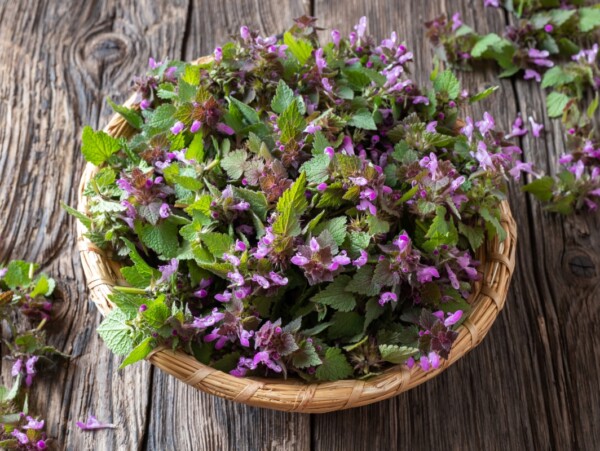










Why don’t you include
nipplewort Lapsana communis ?
Great descriptions .
That one’s yet another yellow flowered weed, but one I haven’t personally found (and honestly, hadn’t even heard of until now). I don’t even have it on my list of 40 common yellow flowered weeds (https://practicalselfreliance.com/weeds-with-yellow-flowers/). I’ll have to add it to both when I go through and do post updates later this winter. Thanks!
Just read your article on dandelions.
I am fairly new to gardening. I am vegan and in my third year of growing veg in the sunny Algarve, Portugal. I dedicated a bed to to what I thought were nettles and dandelions which I transplanted to the bed as young plants. Your posting on dandylions is very informative. Thank you.
So glad it was helpful to you!
Thankyou for your detailed post on Dandelions. It is the most informative, with pictures that i have come across and i will definatly be filing it in my folder for future referance.
Wonderful!
Thank you so much for this post! I’m lousy at plant id — i have face blindness and i swear it extends to plants haha. It was interesting to read that dandelions growing in shade or sun have different shaped leaves. This fact is one reason i was getting so confused about the plants in my yard. The roots of the shaded plants also seem to branch a little more, i think. I’ll have to take another look. Anyway, i’m so excited to have found your site. I’m trying to inspire foraging in my rural Alberta prairie town, and i’m sure your information is going to come in very handy!
So glad this was helpful to you. There are a number of people in my family with face blindness as well, and I’ve seen what a struggle that can be. It totally makes sense it would extend to plants too.
Thank you so much, I started making dandelion ointment a year or so ago and they are so awesome to have for pain relief and eczema, even small cuts… then, by observing the flowers and the plants, I noticed the yellow flowers blooming in my yard (first summer in this house and I am in summer now down at the pacific), I started noticing the difference when I harvest the flowers…. I had down some research previously and couldn’t find anything like your page here, so thoroughly explained, very awesome. Sadly, the yellow flowers in my yard are not dandelions, I think they are “Autumn Hawkbit” from your recommendation
Thank you again and Merry Christmas ( :
You’re very welcome. We are glad it was helpful. Have a Merry Christmas.
Hi! The plant growing wild in my front yard in Brooklyn, NY looks like some of the plants you mention. But the leaf surfaces are smooth as can be, not at all hairy. They only bloom for a couple of days before going white. Here is?a link to the?photo: https://photos.app.goo.gl/YeSwYni5GRTfgSgc9
As a practice, I don’t ID plants for people from photos (too much room for error). I can what it’s not, and it’s not dandelion, but I think you already knew that. I’d suggest using the iNaturalist App to ID it, which works REALLY well. You can upload photos via desktop or do it directly from a device in the app. Best of luck!